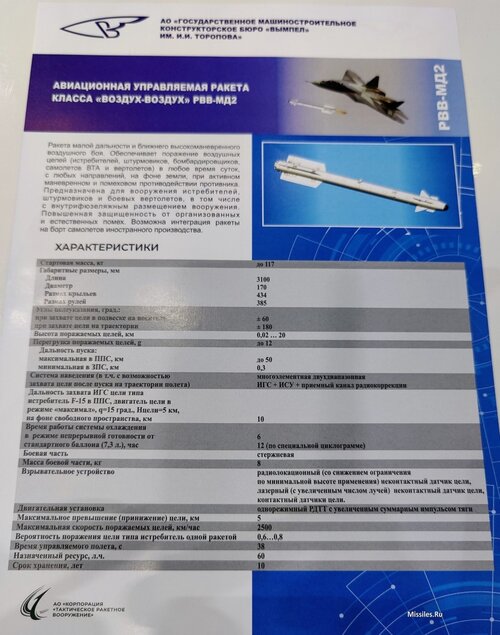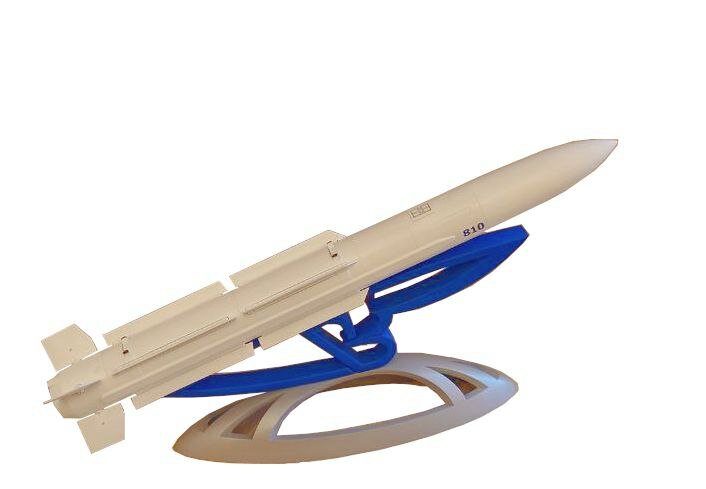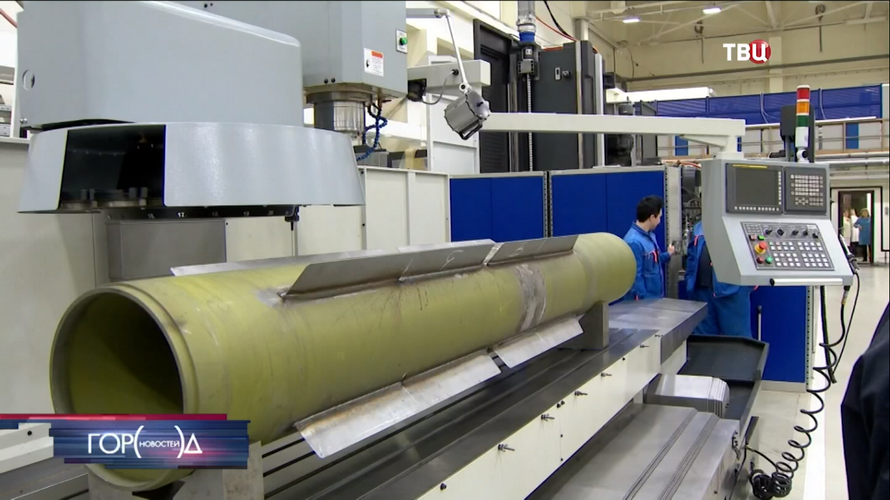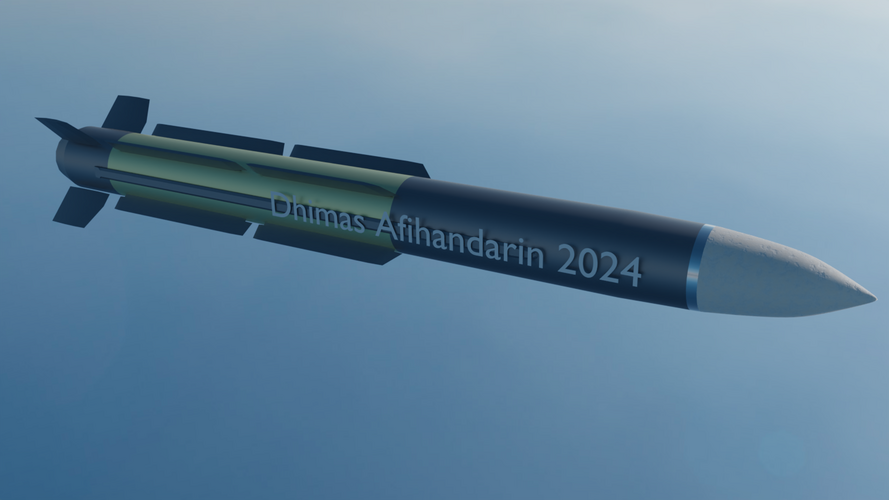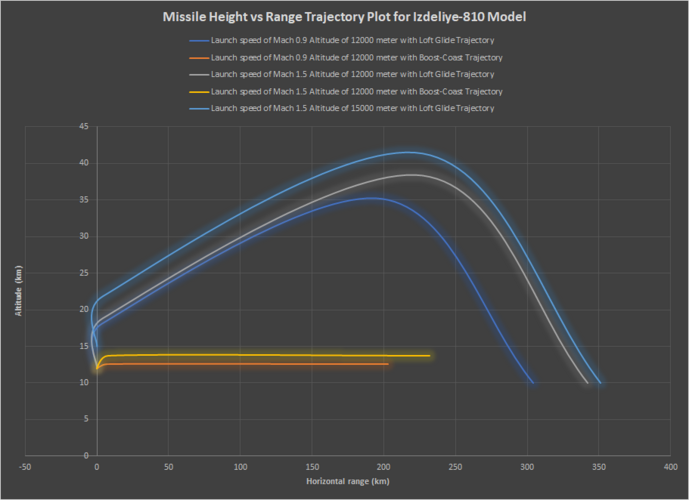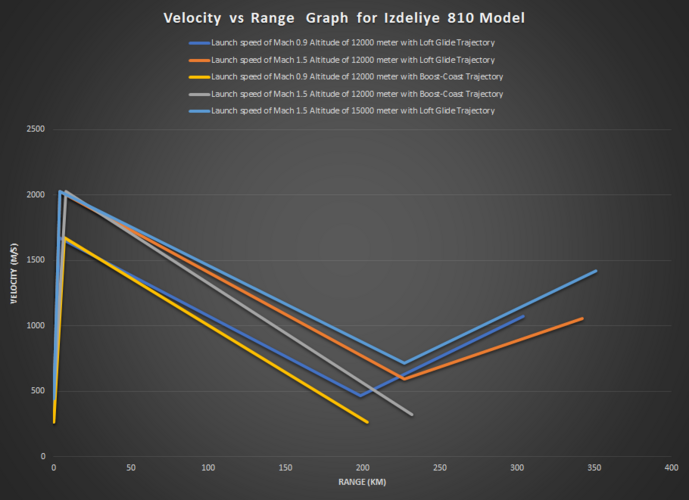Could you please give source? Thanks.Re: Current Russian AAM projects
What happened to the proposed replacement of the R-73 ... I think it was called K-30 ?!
Deino ???
Hard to say
You are using an out of date browser. It may not display this or other websites correctly.
You should upgrade or use an alternative browser.
You should upgrade or use an alternative browser.
Current Russian/Ukrainian AAM projects
- Thread starter overscan (PaulMM)
- Start date
Could you please give source? Thanks.Re: Current Russian AAM projects
What happened to the proposed replacement of the R-73 ... I think it was called K-30 ?!
Deino ???
Hard to say
Of course. It will be surprising for you. See the video, 33:02...
So there was a recent aricle about RVV-MD2 being allegedly 10years more advanced than current Western/US short range AAM's.
There were speculations that it's an rebirth of old izd.300/K-30 project.
But KTRV showed it at still ongoing Army-2023 expo, and there are really nothing new to see.

(photo (c) BMPD)
It's an old R-73 airframe, albeit with new seeker window, which points to a new seeker. And new laser rangefinder for detonator.
However, there is no change in the size of transparent window(like there was with AIM-9X), so there is no improvement in aquisition angle compared to original R-73 (75 degree max, IIRC). Aerodynmic scheme is also unchanged.
So I really don't see how it's more advanced than current AIM-9X/Iris-T/ASRAAM.
There were speculations that it's an rebirth of old izd.300/K-30 project.
But KTRV showed it at still ongoing Army-2023 expo, and there are really nothing new to see.

(photo (c) BMPD)
It's an old R-73 airframe, albeit with new seeker window, which points to a new seeker. And new laser rangefinder for detonator.
However, there is no change in the size of transparent window(like there was with AIM-9X), so there is no improvement in aquisition angle compared to original R-73 (75 degree max, IIRC). Aerodynmic scheme is also unchanged.
So I really don't see how it's more advanced than current AIM-9X/Iris-T/ASRAAM.
Last edited:
It does actually - "multi element" might well be a literal translation or circumscription of the Russian term for focal plane array.
The thing is, although a R-73 with a new seeker sounds a bit boring (and sure as hell isn't 10 years ahead of its Western equivalents!) it would be perfectly adequate. The kinematics and aerodynamics of the Archer airframe remain easily competitive, the only real drawback is that its envelope is now very bulky in an era of internal weapons bays.
The thing is, although a R-73 with a new seeker sounds a bit boring (and sure as hell isn't 10 years ahead of its Western equivalents!) it would be perfectly adequate. The kinematics and aerodynamics of the Archer airframe remain easily competitive, the only real drawback is that its envelope is now very bulky in an era of internal weapons bays.
Last edited:
- Joined
- 4 July 2010
- Messages
- 2,514
- Reaction score
- 3,091
I don't think anyone's seriously accusing it of being inadequate, but the ET piece and fans of a certain letter on social media have been going on about it being a major advance or even a step-change in capabilities. Rather, it looks like a sensible update of an established system.It does actually - "multi element" might well be a literal translation or circumscription of the Russian term for focal plane array.
The thing is, although a R-73 with a new seeker sounds a bit boring (and sure as hell isn't 10 years ahead of its Western equivalents!) it would be perfectly adequate. The kinematics and aerodynamics of the Archer airframe remain easily competitive, the only real drawback is that its envelope is now very bulky in an era of internal weapons bays.
There are also INS + guidance link, like on BVR missiles. Which implies LOAL and increased range (for excample, older RVV-MD stated to have 40km max range), so with both now included, long-range launches might be more effective.
TMA1
ACCESS: Top Secret
- Joined
- 6 February 2021
- Messages
- 556
- Reaction score
- 858
It seems to imply that this isnt the clean sheet izd 300 but instead the R-74m2. Would you guys agree with this? Yeah it is hyperbolic. Though I bet it will indeed be a very good missile. I wonder if this is what is going to be used on the tu-160m as a self defense and anti missile system.
Multi element is often mentioned in english literature when talking about 1980s/1990s infrared seekers. Where several detector elements help defeat flares. Dual band is also often mentioned, usually for short to mid ir wavelengths.It does actually - "multi element" might well be a literal translation or circumscription of the Russian term for focal plane array.
The thing is, although a R-73 with a new seeker sounds a bit boring (and sure as hell isn't 10 years ahead of its Western equivalents!) it would be perfectly adequate. The kinematics and aerodynamics of the Archer airframe remain easily competitive, the only real drawback is that its envelope is now very bulky in an era of internal weapons bays.
While it could be a mistranslation, it's strange that the manufacturer would not boast about imaging infra red outright, instead of using other, descriptions that are more fitting to older technologies.
The the Russian quote was:
"многоэлементная двухдиапазонная инфракрасная головка самонаведения с повышенной помехозащищенностью"
Which translates to "multiple-element two-band IR seeker head with improved CCM"
"многоэлементная двухдиапазонная инфракрасная головка самонаведения с повышенной помехозащищенностью"
Which translates to "multiple-element two-band IR seeker head with improved CCM"
It seems to me that the rear wings (or whatever they are called) have been reduced in span on the RVV-MD2. Which kinda confirm what we saw in the picture from few years ago first showing what is now known to be the RVV-MD2.
Haven't found any mention of it here, but back in 2021 apparently the ukrainians were working on some kind of R-77 derivative called UP-277, differing in having normal instead of lattice rudders.

 bmpd.livejournal.com
bmpd.livejournal.com
Проект украинской управляемой авиационной ракеты УП-277
Как сообщают украинские СМИ, украинское государственное предприятие Государственное Киевское конструкторское бюро Луч на проходящей в Киеве с 15 по 18 июня 2021 года очередной оборонно-промышленной выставке Зброя та безпека-2021 впервые представило макет…
 bmpd.livejournal.com
bmpd.livejournal.com
TMA1
ACCESS: Top Secret
- Joined
- 6 February 2021
- Messages
- 556
- Reaction score
- 858

«Армия-2023». РВВ-МД2
В соответствии с распространенной в преддверии форума «Армия-2023» информацией, заранее стало известно о том, что будет представлена новая управляемая авиаракета класса «воздух-возду…
 missiles.ru
missiles.ru
Saw this article with images of the new rvv-md2/r-74m2. Looks pretty awesome. Over at russiadefenseforum they were translating some of the info from the brochure. Here are some pics from the article above.
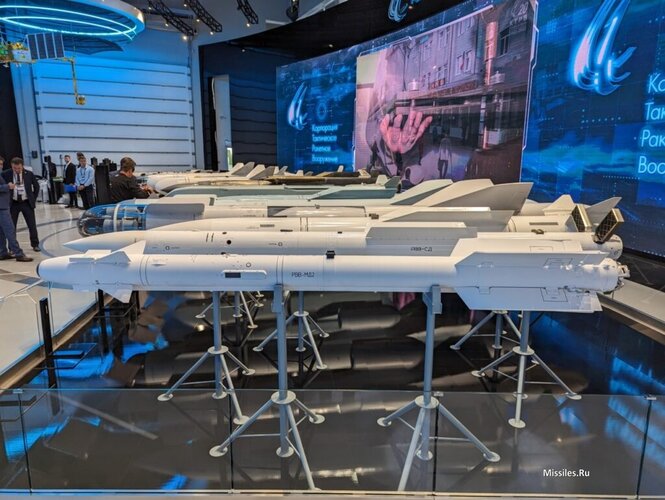
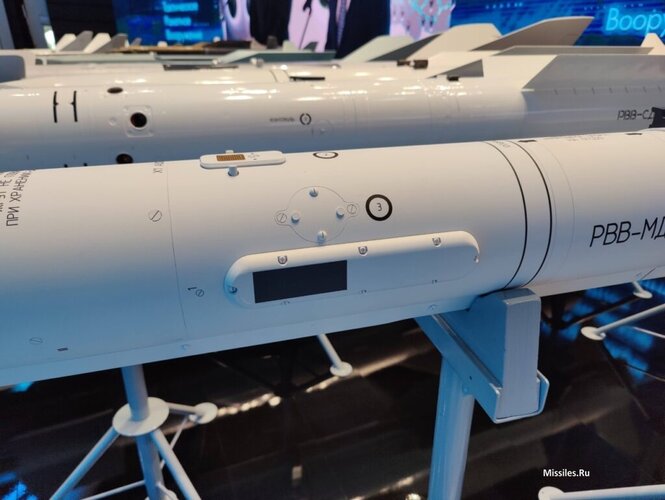
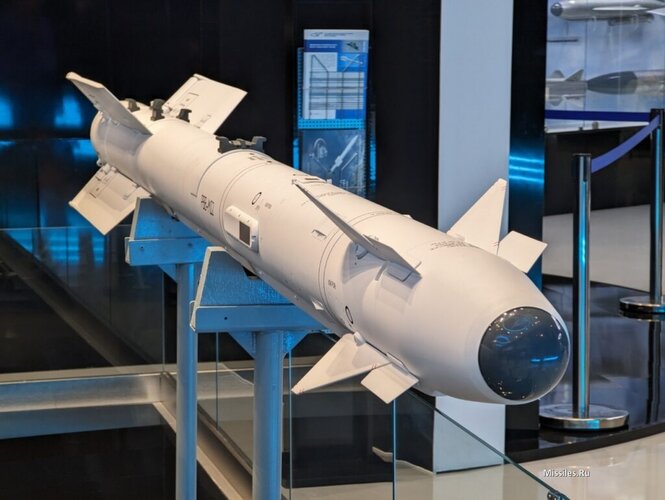
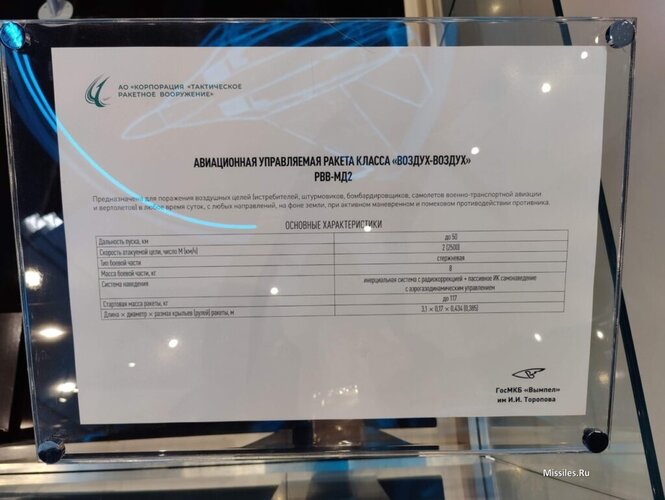
Specifications:
Maximum launch range (meaning target range, not flyout range): 50km
Max target speed, Mach(km/h): 2(2500)
Warhead: continuous rod
Guidance: INS with mid-course update + passive IR seeker and aero gas dynamic guidance
Launch mass: 117kg
Length x diameter x wigspan (rudders), m: 3.1 x 0.37 x 0.434 (0.385)
Maximum launch range (meaning target range, not flyout range): 50km
Max target speed, Mach(km/h): 2(2500)
Warhead: continuous rod
Guidance: INS with mid-course update + passive IR seeker and aero gas dynamic guidance
Launch mass: 117kg
Length x diameter x wigspan (rudders), m: 3.1 x 0.37 x 0.434 (0.385)
looks like you're indeed right, here wigspan is stated as 0.434m, official data for R-73 is 0.51mIt seems to me that the rear wings (or whatever they are called) have been reduced in span on the RVV-MD2. Which kinda confirm what we saw in the picture from few years ago first showing what is now known to be the RVV-MD2.
Last edited:
Scott Kenny
ACCESS: USAP
- Joined
- 15 May 2023
- Messages
- 11,599
- Reaction score
- 14,269
Say what?Specifications:
Maximum launch range (meaning target range, not flyout range): 50km
Max target speed, Mach(km/h): 2(2500)
Warhead: continuous rod
Guidance: INS with mid-course update + passive IR seeker and aero gas dynamic guidance
Launch mass: 117kg
Length x diameter x wigspan (rudders), m: 3.1 x 0.37 x 0.434 (0.385)
- Joined
- 16 April 2008
- Messages
- 9,604
- Reaction score
- 14,490
Say what?
Russian phrasing for thrust-vectoring.
Scott Kenny
ACCESS: USAP
- Joined
- 15 May 2023
- Messages
- 11,599
- Reaction score
- 14,269
Seems odd to put it into guidance, but okay.Russian phrasing for thrust-vectoring.
Thanks!
RVV-MD2View attachment 706306Export(?) RVV-MD2 brochure
Specifications:
Launch mass: up to 117kg
Dimensions, mm
Length: 3100
Diameter: 170
Wingspan: 434
Rudder span: 385
Cueing angles:
at pylon: +-60deg
at trajectory: +-180
Target altitude range: 0.02-20km
Max target G load: up to 12
Firing range:
max target front hemisphere: up to 50km
min target rear hemispehere: 0.3km
Seeker and guidance: multi-element two-band IR seeker + INS + mid-course update
Seeker lock on range, target: F-15 frontal hemisphere, engines at MIL thrust, q=15deg, target altitude = 5km, free background: 10km
Cooling system time at uninterrupted readiness mode, with a standard balloon volume of 7.3L, hours: 6/12(using special cyclogram).
Warhed: continuous rod
Warhead weight: 8kg
Detonator: radar detector with lowered restrictions on min altitude, laser detector with increased number of beams
Motor: single-mode rocket motor with increased overall thrust impulse
Max target height difference: 5km
Max target speed: 2500 km/h
Pk, target fighter: 0.6-0.8
GFuided flight time: 38s
Max flight
hours on pylon: 60
Storage time: 10years
Last edited:
Scott Kenny
ACCESS: USAP
- Joined
- 15 May 2023
- Messages
- 11,599
- Reaction score
- 14,269
How does that compare to typical Western missiles?Max flight hours on pylon: 60
Storage time: 10years
TMA1
ACCESS: Top Secret
- Joined
- 6 February 2021
- Messages
- 556
- Reaction score
- 858
Good question. I seem to recall that these are pretty normal numbers for Russian/soviet missiles as far as shelf life and air time goes. The seeker arming time span seems much improved tho. I think these are pretty normal figures for times before a required overhaul. I've heard our missiles have longer shelf lives but I'm not sure.
- Joined
- 16 April 2008
- Messages
- 9,604
- Reaction score
- 14,490
How does that compare to typical Western missiles?
In 1984, AMRAAM was reportedly being designed for 50 flights of 2 hours, so 100 hours in flight. But by the 1990s, missiles were achieving 200 flight hours between required maintenance, with the goal being 450 hours.
- Joined
- 11 February 2010
- Messages
- 1,649
- Reaction score
- 2,698
GFuided flight time: 38s
Max flight
hours on pylon: 60
Storage time: 10years
That Guided flight time is some good improvement over 23-28 seconds for earlier R-73 variants. The storage time is also improved by about 2 years.
Typical Russian A2A missiles, export at least have storage life of 8 years. The missile come with a "calendar" to predict the remaining life of the missile. This is for RVV-AE.

Scott Kenny
ACCESS: USAP
- Joined
- 15 May 2023
- Messages
- 11,599
- Reaction score
- 14,269
That's honestly a pretty slick trick, and interesting markings...
I may have to steal that idea for a story.
I may have to steal that idea for a story.
Last edited by a moderator:
The first row aren't control surfaces but weather-vaning air-data (AoA/side-slip angle) sensors. These may have become redundant with the introduction of an INS into the guidance system.
Last edited:
aonestudio
I really should change my personal text
- Joined
- 11 March 2018
- Messages
- 2,964
- Reaction score
- 7,492
Avimimus
ACCESS: Top Secret
- Joined
- 15 December 2007
- Messages
- 2,426
- Reaction score
- 907
Interesting. I see some discrepancies between the number of missiles claimed per airframe, and the number illustrated (with the latter being plausible).
However, it does seem to support the idea that the RVV-BD isn't cleared for internal stowage.
I've generally assumed that an I-810 derived ("R-37 class") missile was being developed for the PAK-FA, given that ti appears to have 700kg ejectors and given the potential benefits of having the additional kinematic performance and seeker diametre (which allows more development potential/growth in performance to match low observable targets). However, I suppose it might also be plausible that the stealth configuration of the Su-75 will be limited to the RRV-SD, with the RVV-BD class weapons carried externally only?
However, it does seem to support the idea that the RVV-BD isn't cleared for internal stowage.
I've generally assumed that an I-810 derived ("R-37 class") missile was being developed for the PAK-FA, given that ti appears to have 700kg ejectors and given the potential benefits of having the additional kinematic performance and seeker diametre (which allows more development potential/growth in performance to match low observable targets). However, I suppose it might also be plausible that the stealth configuration of the Su-75 will be limited to the RRV-SD, with the RVV-BD class weapons carried externally only?
I've seen a snippet of info that says the Su-57 could carry up to 10 Izd. 810 AAMs (tailored for internal carriage), 4 in the bays, 4 under the wings and 2 under intakes. There was also a R- designation, though not sure if that info is supposed to be public
Probably such a configuration is as likely as the F-14 carrying 6 AIM-54s operationally, ie most likely not in any day to day operations.
Given the above, i guess the Su-57E could carry up to a maximum of 6 RVV-BDs (R-37M, Izd. 610M iirc) under wings and intakes, since the RVV-BD is not tailored for internal carriage.
Probably such a configuration is as likely as the F-14 carrying 6 AIM-54s operationally, ie most likely not in any day to day operations.
Given the above, i guess the Su-57E could carry up to a maximum of 6 RVV-BDs (R-37M, Izd. 610M iirc) under wings and intakes, since the RVV-BD is not tailored for internal carriage.
However, it does seem to support the idea that the RVV-BD isn't cleared for internal stowage.
I've generally assumed that an I-810 derived ("R-37 class") missile was being developed for the PAK-FA, given that ti appears to have 700kg ejectors and given the potential benefits of having the additional kinematic performance and seeker diametre (which allows more development potential/growth in performance to match low observable targets). However, I suppose it might also be plausible that the stealth configuration of the Su-75 will be limited to the RRV-SD, with the RVV-BD class weapons carried externally only?
TMA1's post provides the answer: RVV-BD =/= Izd. 810. So yes, the former (which is basically the R-37M in Russian domestic service) cannot be carried inside the Su-57 bays (chiefly because only the upper control surface pair folds), whereas the Izd. 810 can.
Last edited:
- Joined
- 11 February 2010
- Messages
- 1,649
- Reaction score
- 2,698
That's interesting to see that "split strakes" I wonder why such design decision.
Related to turning performance, at a guess. Perhaps the gap which short-circuits the pressure and suction sides of the strake somehow improves unsteady flow at high AoA? Sort of a fowler flap cum dog tooth?
- Joined
- 11 February 2010
- Messages
- 1,649
- Reaction score
- 2,698
- Joined
- 11 February 2010
- Messages
- 1,649
- Reaction score
- 2,698
Some range estimates based on the dimensions. This time i assume 4.2 m length.
View: https://vxtwitter.com/Flankerchan/status/1745294250907197517
The modeled trajectory would be Loft glide (or boost glide) and Boost-coast "direct fire". For launching condition, two conditions are estimated. Subsonic (M 0.9) and Supersonic/supercruise (M 1.5) With launch altitude of 12000 meter. Target are assumed to be in 10000 meter for Loft glide which, typical operational altitude of an AEW aircraft. While for "direct fire" are Co altitude which could be representative for fighter aircraft.
The assumed launch weight would be 650 Kg. Heavier than Izd 610 (RVV-BD) As i use methods of estimate from E Fleeman's tactical missile design. The weight prediction there actually assume 671 Kg which i corrected (well Agat seeker is light afterall + Digital IMU and autopilot) to 650 Kg.
Propellant load is assumed to be 250 Kg. The weight breakdown is as follows :

Engine + accs is the weight of the rocket motor casing and nozzles without the propellant. GCS stands for Guidance and Control System. The battery is surprisingly heavy as i assume Thermal battery, 10 KW power requirement for 700 seconds of flight (100 seconds more than R-33).
The resulting range with those assumptions :

and speed-range diagram

Well one can see 11-12% increase in range from supersonic launch. Also visible the Apogee. Could be excessive tho.
View: https://vxtwitter.com/Flankerchan/status/1745294250907197517
The modeled trajectory would be Loft glide (or boost glide) and Boost-coast "direct fire". For launching condition, two conditions are estimated. Subsonic (M 0.9) and Supersonic/supercruise (M 1.5) With launch altitude of 12000 meter. Target are assumed to be in 10000 meter for Loft glide which, typical operational altitude of an AEW aircraft. While for "direct fire" are Co altitude which could be representative for fighter aircraft.
The assumed launch weight would be 650 Kg. Heavier than Izd 610 (RVV-BD) As i use methods of estimate from E Fleeman's tactical missile design. The weight prediction there actually assume 671 Kg which i corrected (well Agat seeker is light afterall + Digital IMU and autopilot) to 650 Kg.
Propellant load is assumed to be 250 Kg. The weight breakdown is as follows :
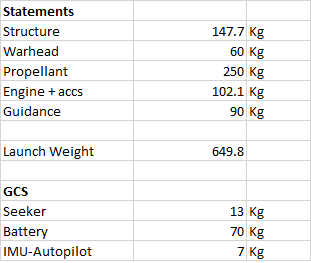
Engine + accs is the weight of the rocket motor casing and nozzles without the propellant. GCS stands for Guidance and Control System. The battery is surprisingly heavy as i assume Thermal battery, 10 KW power requirement for 700 seconds of flight (100 seconds more than R-33).
The resulting range with those assumptions :
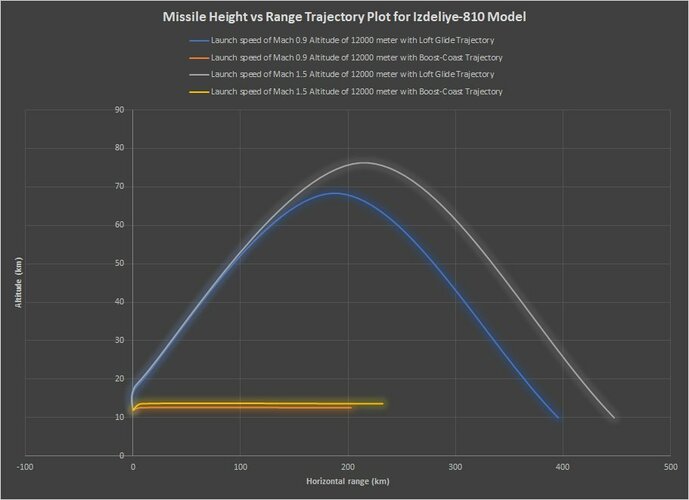
and speed-range diagram
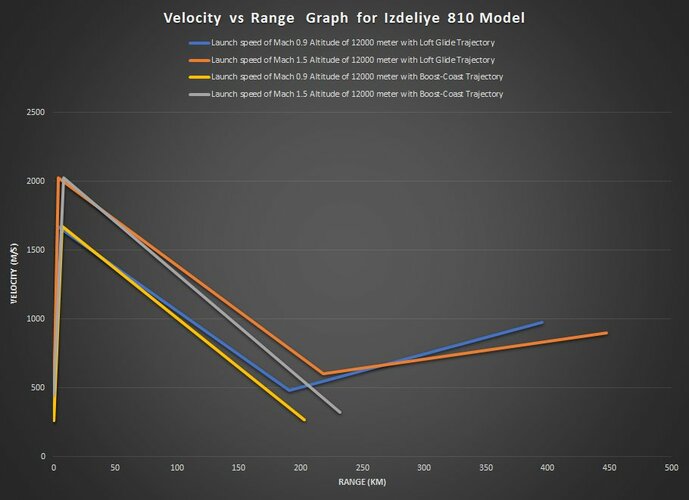
Well one can see 11-12% increase in range from supersonic launch. Also visible the Apogee. Could be excessive tho.
Can you perhaps add a lofted trajectory that doesn't go quite that high? An apogee of 30 - 40km would ensure the missile does not spend so much time at altitudes where air density (or rather lack thereof) precludes course correction by aerodynamic control surfaces. Your lofted trajectories basically have the missile unable to react to even mild mid-course updates for 300 of the 450km flight, which may then require very aggressive turning during the final 50km or so. Even against an AEW aircraft that's probably a bit tight (it flies a race track, rather than a nicely predictable straight line).
Last edited:
- Joined
- 11 February 2010
- Messages
- 1,649
- Reaction score
- 2,698
I'm quite curious about how increased diametre and weight (i.e. more battery) could possibly be used to improve seeker performance
Increased battery endurance allows the missile to still able to guide itself, long even after motor burn out, allowing high apogee glide phase where the missile using its control surfaces to do things like energy management maneuver and of course use of higher power radar seeker.
While large diameter is basically allows larger antenna means longer range and narrower beamwidth which basically improved angular resolution. The following is some benefit of larger diameter missile
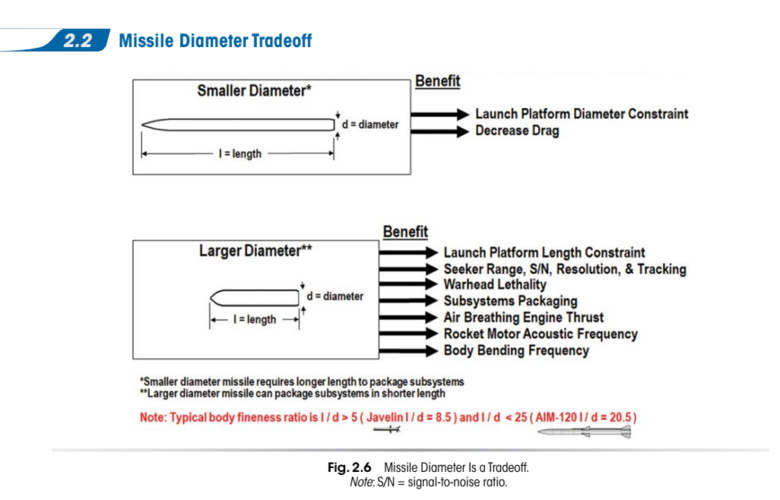
Can you perhaps add a lofted trajectory that doesn't go quite that high? An apogee of 30 - 40km would ensure the missile does not spend so much time at altitudes where air density (or rather lack thereof) precludes course correction by aerodynamic control surfaces. Your lofted trajectories basically have the missile unable to react to even mild mid-course updates for 300 of the 450km flight, which may then require very aggressive turning during the final 50km or so. Even against an AEW aircraft that's probably a bit tight (it flies a race track, rather than a nicely predictable straight line).
Sure thing, which obtained by adjusting the angle of the missile during coast, with something flatter. In this one it's where the Apogee is limited to Below 45 Km. Not giving the previous 400+ km range but still respectable 300-350 Km. Maybe it can reach more if i can assume higher L/D (In my model for glide phase, i assume L/D ratio of 3). The missile also retain somehow more "energy" in shape of velocity.
Similar threads
-
Vympel Izdeliye 550 long-range AAM project
- Started by overscan (PaulMM)
- Replies: 1
-
Article Related to Some of Russian Air Launched Missile Programme
- Started by ocay
- Replies: 0
-
-
-
Soviet Bissektor AAM (1968)
- Started by overscan (PaulMM)
- Replies: 3

